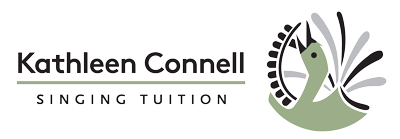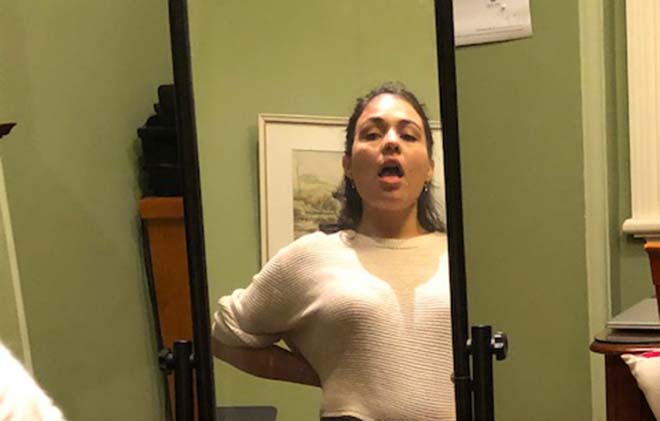From the top: learn the basics of breathing for singing. Part 1 – Inhalation
When you start learning to sing, breathing training is a fundamental skill that requires much thinking, focus and practice. You have to train your body to manage your breath so you can sing a variety of phrases, rhythms and musical intervals.
In this blog series, I will break down the breathing process into its three essential parts: inhalation, exhalation and how to combine and co-ordinate both, to produce a quality vocal tone.
LET’S LOOK AT INHALATION.
Learning to inhale properly is one of the first steps in singing training. Here, I’ll guide you through the fundamental physical aspects, with exercises to improve your understanding of how breathing for singing works.
Good posture and body alignment are crucial to taking controlled deep, low and full breaths. 
Exercise: Standing balanced on both feet and lengthening the spine, neck and chest, inhale slowly and imagine your breath going down into your feet. Inhaling too quickly, you may gasp your inbreath, raising your rib cage and narrowing your throat space, which interferes with your voice’s tonal quality. The slower your inhale the better to understand and feel the action.
Exercise: Place one hand on your chest, the other at your abdomen. As you inhale, your hand at your chest should stay steady, and not rise too much, while the hand at your abdomen will feel the muscles move outwards and then slowly back, as you exhale.
Opening your mouth is important in training the soft palette to rise to eliminate any nasality and allow the air to flow out, giving your voice a well-developed tonal quality.
Exercise: Open your mouth, without over-widening, and relax your jaw to intake breath. Imagine your jaw is like a hinge opening and feel space in your mouth and throat as the breath flows through.
Exercise: Sing the tune ‘Happy Birthday’, without words, instead using a ‘Z’ sound, a lip buzz or tongue trill. The point is to notice the inbreath at the end of each phrase. Make sure your inbreaths are slow, low and through a relaxed, open mouth. This song has small intervals, some wide intervals, and some short and long phrases, so you have to plan for the full use of your breath.
Remember, singing is thinking. You have to learn how to plan for an inbreath, how your body will open and what you want to achieve with inhalation. At first, this may feel counter intuitive but this slow, deliberate approach sets you up for success as you progress to more challenging vocal exercises and songs.
Now we move to the lower part of your torso.
Breathing into your lower torso means letting go of some of the muscles here. Again, this requires thinking, to focus on this area and mindfully release it.
Exercise: With your mouth open and jaw relaxed, think about letting your abdominal muscles invite air into your lungs, rather than taking a big breath. You’ll know you’re doing this right when you feel your lower ribs open up or stretch, creating more space to allow air in. Gradually you’ll learn to open your back muscles and ribs without effort. This is a more advanced inhalation where by just opening the lower torso, air ‘drops in’.
Exercise: Place your hands on your hips and move them back a little. You’ll feel the indentation just above the hip bone. Breathe into this area and feel this part of your body expanding. It’s a small, subtle expansion, so keeping your hands there helps you notice it. Getting used to observing and feeling these muscles moving when you inhale will help when you progress to singing more challenging repertoire.
Exercise: Place your hands around your rib cage, inhale slowly and feel the stretch. The aim is to feel the ribs opening and staying open a little longer than for everyday breathing. This is known as ‘suspension’ and aids in slowing the out breath, helping to manage breath flow. For beginners, opening or stretching the ribs out can feel counter intuitive, but awareness and benefits come with regular practice, even in short sessions.
Releasing your low abdominals on the inbreath is another important part of efficient and successful inhalation.
Exercise: Bend forward, hands gently on your knees, while keeping length through your torso and into your neck and head. Without breathing, let your tummy muscles drop, then engage and bring them back towards your spine – repeat a few times. Next, engage your abdominals while saying a clear ‘SSSHHHH’. Then release your low abs while inhaling. Do this several times until you feel the ease of allowing your belly wall to release on inhalation, then engage on exhalation.
forward, hands gently on your knees, while keeping length through your torso and into your neck and head. Without breathing, let your tummy muscles drop, then engage and bring them back towards your spine – repeat a few times. Next, engage your abdominals while saying a clear ‘SSSHHHH’. Then release your low abs while inhaling. Do this several times until you feel the ease of allowing your belly wall to release on inhalation, then engage on exhalation.
All these exercises work your diaphragm, too – which is essential to sustainable singing. While we can’t feel our diaphragm because it has no nerve endings, by using your sides, back, ribs and abdominals, your brain receives feedback that your diaphragm is moving, helping you breathe efficiently to sing with greater ease.
Starting slow, and guided by a patient singing teacher, you learn to inhale faster and more securely, gaining vocal strength and flexibility, until it becomes muscle memory and your body does what your ever-active, switched-on singing brain tells it to do.
Owning and finessing these voice technique habits early is worthwhile, so you can explore more complex repertoire. It’s also part of your commitment to singing training, giving you skills you can call on, whatever your singing goals.
For personalised guidance on breathing for singing, enquire about singing lessons for beginners or advanced learners, with Kathleen Connell. Get in touch.



